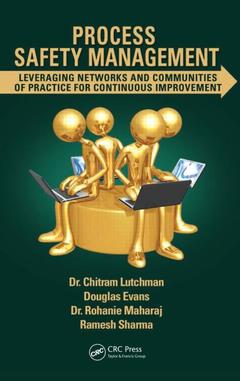Process Safety Management Leveraging Networks and Communities of Practice for Continuous Improvement
Auteurs : Lutchman Chitram, Evans Douglas, Maharaj Rohanie, Sharma Ramesh

The continued prevalence of major incidents (most recently the 2010 BP Gulf of Mexico Oil Spill) and preponderance of workplace fatalities and injuries as well as Process Safety Management (PSM) Incidents, globally, begs the question: why do incidents continue to occur in today?s technologically advanced era? More importantly, with 80-85 percent of incidents being repeated, the more obvious questions are:
- Why do organizations fail to learn from prior incidents internal to the business?
- Why do organizations fail to learn from their peers and other same industry players?
- Why do organizations fail to learn from the incidents and experiences of other industries?
Process Safety Management: Leveraging Networks and Communities of Practice for Continuous Improvement provides a road map organizations can use to identify and setup critical networks for preventing catastrophic incidents and for sharing knowledge in an organized manner within the organization to enhance business performance. The book helps organizations establish centers of excellence by activating networks for generating best practices and practical solutions to workplace business, and safety challenges.
The book covers the full range of activation of networks including identifying members, defining goals and objectives, and prioritizing work through leadership and stewardship of networks. It addresses all elements of effective safety management and includes simple, easy-to-follow processes that bring about lasting changes to workplace safety. It also highlights the health and safety needs of both Generation X and Generation Y who currently inherit the workplace but are very different in learning behaviors and experience levels.
In a thin margins business environment characterized by scarce resources, operational discipline and excellence drives stakeholder confidence and corporate performance. Detailing the practical application of tested principles and practices, this book provides a simple path forward for organizations to recognize the benefits of networks and to proactively establish and support them within organizations to generate continuous and sustained improvement in work practices, procedures, and business performance.
Historical perspective – Review of Operationally Discipline / Excellent Organizations. Elements of an Operationally Excellent Management System. Leadership Behaviors for Operational Discipline and Excellence. Setting the Baseline. Identifying and Prioritizing the Gaps. Networks - Defining Membership. Activating and Tenure Setting for the Network. Network Conference – Training and Chartering. Network Focus and Work Priorities. Defining the Community of Practice. Network Performance Management and Monitoring. Performance Targets and Key Performance Indicators. Sharing Learnings and Best Practices for Sustained Success. Conclusion. References.
Date de parution : 07-2013
Ouvrage de 248 p.
15.6x23.4 cm
Thèmes de Process Safety Management :
Mots-clés :
PSM; PSM Element; workplace fatalities and injuries; Pre-startup Safety Reviews; prevent catastrophic incidents; Contractor Safety Management; Leadership Behaviors; Face To Face; Excellent Organizations; Core Team Members; Network Focus; Core Team; Work priorites; PHA; Key Performance Indicators; Network Charter; Process Safety; Operational Discipline; Om; Operations Discipline; Ne Ss; Steering Team; Business Process; Network Members; Process Safety Information; Contractor Safety; Competency Assurance; Collaboration Site; Pe Rc; Ac Ti; ABCD; Network Leader



